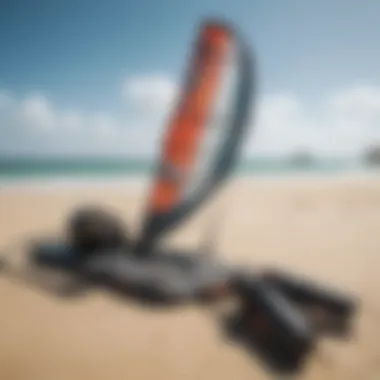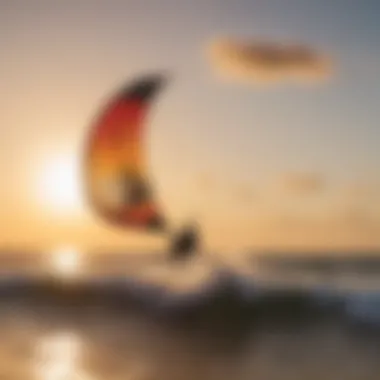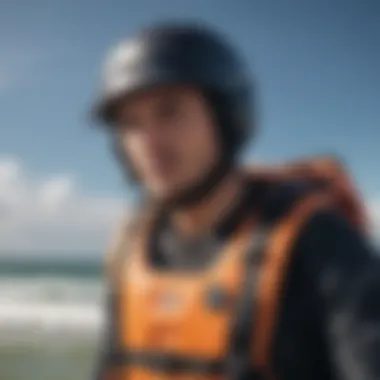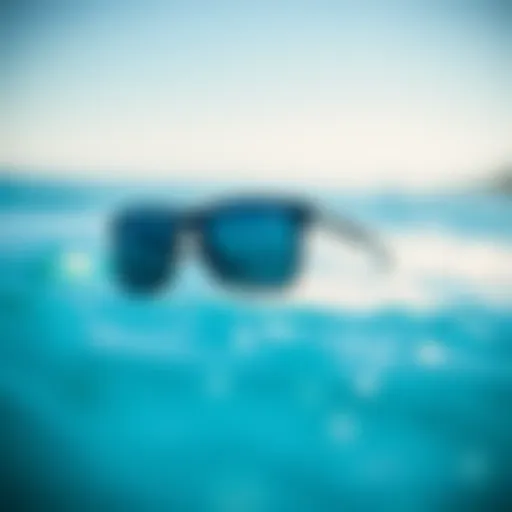Essential Kitesurfing Gear Guide for Newcomers


Intro
Kitesurfing has rapidly become a favorite pastime for many thrill-seekers and beach lovers alike. Yet, as exhilarating as it is to ride the wind and waves, entering the world of kitesurfing can feel a bit overwhelming at first. With the myriad of equipment available, it’s crucial to understand what you need to make informed decisions. Therefore, this guide explores the essential gear that beginners must consider, ensuring a smoother trajectory into this exhilarating sport. From selecting the right kites to mastering basic techniques, we’ll provide a clear path through the complexities of kitesurfing gear and its proper usage.
Gear Selection
Selecting the right gear is pivotal for anyone looking to make a splash in kitesurfing. Not only does it affect your performance on the water, but it also plays a significant role in your overall safety and enjoyment.
Types of Kites
Kites are the heart of kitesurfing. A beginner typically encounters three primary types of kites:
- Foil Kites: These kites create lift using an airfoil shape but require a bit more finesse to control. They are great for light wind conditions and offer a steady pull.
- LEI Kites (Leading Edge Inflatable): The most common choice for novices, LEIs are inflatable, making them easy to manage. They provide buoyancy and stability, ideal for varied wind conditions.
- Hybrid Kites: As the name suggests, this type mixes features from both foil and LEI designs. They’re versatile and cater to various skill levels.
When choosing a kite, consider factors like wind conditions in your area, your weight, and your skill level. A larger kite catches more wind, making it suitable for lighter conditions, while a smaller kite is better for stronger winds.
Choosing the Right Board
The board is your foundation for kitesurfing. Beginners generally choose from two main types:
- Twin Tip Boards: These are often recommended for starters due to their symmetrical shape, allowing riders to tackle the water in either direction. They also make jumping more accessible to learn.
- Directional Boards: More common among surfers, these boards excel in waves but can be tricky for beginners who want to master the basics.
When deciding on a board, consider your weight and the specific conditions where you’ll be riding. Comfort with the gear can make all the difference as you seek to boost your skills.
Skill Development
Once you’ve nailed down the gear, the next step involves honing your skills.
Essential Techniques
To kickstart your kitesurfing journey, here are a few fundamental techniques:
- Understanding Wind Dynamics: Familiarize yourself with how wind interacts with your kite. This includes recognizing wind windows and their influence on kite control.
- Body Positioning: Keeping a proper stance is essential. It’s crucial to maintain balance, especially when learning to ride on the board.
- Water Starts: This technique involves getting up on your board from the water and requires practice to perfect. It’s often considered a significant milestone for beginners.
Progression Tips
Advancing in kitesurfing requires regular practice and overcoming common hurdles:
- Join a local kitesurfing group or enlist the guidance of an instructor to gain insights and encouragement.
- Document your progress. It’s rewarding to look back and see how far you’ve come.
- Aim for consistency, even if it means shorter sessions in the beginning. This strategy solidifies muscle memory and perfects your techniques over time.
“Mastering kitesurfing is not just about equipment; it’s about understanding your surroundings and becoming one with the wind.”
Expanding your kitesurfing knowledge entails not just gear but also the environment it takes place in. Keeping an ear to the ground helps understand safety measures and the ecological impact associated with this thrilling sport. By nurturing your growth in skills and fostering a connection with the kitesurfing community, your journey becomes as enriching as the experience itself.
Prelude to Kitesurfing Gear
Kitesurfing, a thrilling blend of surfing and flying, demands not only skill but also the right gear to ensure both an exhilarating and safe experience. For beginners stepping into this sport, understanding the components of kitesurfing gear is essential. Riding the waves while being lifted by the wind can be a surreal experience, but without the appropriate equipment, it can quickly become daunting or even dangerous.
Understanding Kitesurfing
Kitesurfing involves harnessing the power of the wind with a kite to propel oneself across the water on a board. It's a sport that combines athleticism and artistry; one moment you might be cruising over the waves, and the next, you could be soaring in the air. For those new to the scene, familiarizing yourself with the nuances of kitesurfing gear is crucial. This understanding not only helps in making informed choices but also enhances your enjoyment of the sport. As you dive deeper, you'll discover that the various types of kites, boards, and harnesses each offer distinct features and benefits tailored for optimal performance.
Importance of Quality Gear
When embarking on your kitesurfing adventure, investing in quality gear is paramount. Poorly constructed or low-quality equipment can lead to safety issues and a frustrating experience on the water. Consider this: would you trust a flimsy parachute when jumping from a plane? Similarly, in kitesurfing, the quality of your kite and board significantly impacts your safety and performance.
Here are some benefits of opting for top-notch kitesurfing gear:
- Durability: High-quality materials withstand harsh conditions, extending the lifespan of your equipment.
- Performance: Well-designed gear enhances responsiveness and control, making it easier to ride and navigate.
- Safety: Quality gear is more reliable during unexpected situations, providing better safety features such as reliable quick-release systems.
In the long run, the minor expense of quality gear up front can save you from costly repairs or unsafe situations down the line. Therefore, take the time to research, ask questions, and test equipment before making a purchase.
"The right gear can make waves, but the wrong gear can cause riptides."
In summary, a solid grasp of kitesurfing gear components is not just beneficial—it's essential for anyone who wishes to ride successfully and safely. The next sections will delve deeper into the heart of kitesurfing equipment, guiding you on your path to becoming a competent kitesurfer.
Essential Kitesurfing Equipment
When diving into the world of kitesurfing, understanding the essential equipment is crucial. The right gear not only enhances the enjoyment of the sport but also ensures safety and efficiency while harnessing the wind. Having a solid grasp on the various components can set beginners on the right course, making their journey into kitesurfing much smoother.
Kite Types Explained


Kites are the heart and soul of kitesurfing. Knowing which type suits one's style and conditions is paramount to a successful experience on the water. There are three main types of kites: Leading Edge Inflatable (LEI), Foil Kites, and Hybrid Kites.
Leading Edge Inflatable (LEI)
LEI kites are perhaps the most popular choice among beginners, and for good reason. They are constructed with inflated struts along the leading edge, which gives them buoyancy and a stable structure. This buoyancy is a key trait that allows them to remain inflated during freestyle tricks or high winds.
Additionally, LEI kites are forgiving and easy to relaunch from the water. If you fall—a frequent occurrence for beginners—these kites can typically be flipped upright and redistributed quickly, getting you back to riding in no time. However, their size and inflation process can be a little cumbersome for those still figuring out the sport.
Foil Kites
Foil kites open up a new world of efficiency and performance. Unlike LEIs, these kites do not require air to stay inflated, featuring internal cells that create an aerodynamic structure. This unique aspect allows for lighter weight and better performance in low wind conditions.
Many riders love foil kites because they offer incredible upwind performance, allowing you to cover more distance with less effort. Still, they might pose a bit of a challenge when it comes to relaunching after a fall, especially for those new to kitesurfing.
Hybrid Kites
Hybrid kites offer a combination of characteristics from both LEI and foil kites. They are designed to be versatile, making them a great option for a variety of conditions and skill levels. With features like inflatable leading edges and multiple internal cells, these kites provide stability and performance.
For beginners, they present a great balance: not too complicated but still packing in a performance edge. However, as a new kiteboarder, you might find the various options a tad overwhelming, so it may be wise to seek guidance before investing.
Selecting the Right Board
Choosing the right board can make or break your kitesurfing experience. The board acts as the extension of your body, translating your movements into gliding effortlessly across the water. Boards come in various shapes and sizes, each designed for different riding styles and conditions.
Types of Boards
Every rider has their preference, depending on their style and what conditions they'll be kiting in. The most common types include twin-tips, directional boards, and freestyle/freeride boards. Twin-tips, for instance, are symmetrical and perfect for beginners as they can ride switch without flipping the board.
Directionals are best for those focusing on surfing and wave riding, whereas freestyle boards are intended for advanced tricks and maneuvers. Each type brings its unique attributes, allowing kitesurfers to tailor their experience.
Board Size Considerations
Board size is another crucial aspect. A larger board floats better and is easier to balance on, making it a preferred choice for beginners. Smaller boards offer greater agility and speed but can be trickier to manage, so it is advisable for novices to stick with larger boards until comfort levels rise.
Material Choices
Materials also play a key role in board selection. Most boards are made from a combination of fiberglass, wood, and various foam materials, influencing factors like weight, durability, and overall performance. For beginners, opting for a board designed for durability makes sense as they tend to be bomb-proof, handling more rough-and-tumble use.
Harness Options
Just like boards and kites, harnesses are another critical piece of gear that directly impacts performance and comfort on the water. Choosing the right harness is essential to ensure your kitesurfing experience is pain-free and enjoyable.
Waist Harness
Waist harnesses sit around your waist, distributing force evenly. This style allows for greater freedom of movement and is favored by many freestyle riders who require agility when executing tricks. However, a waisted harness might ride up, resulting in uncomfortable pressure on the ribs if not fitted correctly.
Seat Harness
On the flip side, a seat harness extends down to the thighs, providing superior support and preventing rides up. For beginners struggling with balance, this style offers more stability on the board. Nonetheless, some riders may feel restricted, so it all boils down to personal preference.
Differences and Preferences
Ultimately, the difference between harnesses boils down to comfort and riding style. New riders should sample both kinds to determine which feels best. Also, factors like adjusting straps and fit can make a world of difference, so take your time during selection.
In summary, getting the right kitesurfing gear is vital for any budding enthusiast. With the right knowledge of kite types, boards, and harness options, beginners can ensure their initial experiences on the water are as sublime as they envision.
Safety Gear and Accessories
In the realm of kitesurfing, the thrill of gliding over waves can sometimes overshadow a crucial aspect—the importance of safety gear and accessories. All seasoned kiteboarders know that enjoying the sport with a healthy dose of caution can profoundly affect not just your experience but also your longevity in this exhilarating activity. The right safety equipment not only protects you in unpredictable conditions but also enhances your confidence on the water, ultimately leading to a more enjoyable time.
The Importance of Safety Gear
When you're cruising through the water, it’s all too easy to underestimate the hazards that lie ahead. Safety gear becomes a lifeline, both literally and figuratively. Imagine this: you're powering up a kite, and an unforeseen gust pops up. With appropriate safety equipment, including harnesses and impact vests, you are less likely to suffer serious injuries if things go south. It’s akin to wearing a seatbelt when in a car—one moment of precaution can keep you safe in the event of an accident.
Moreover, many countries or locations where kitesurfing is popular have specific regulations requiring safety equipment. Compliance with these regulations not only keeps you protected but ensures that you can partake freely without facing fines or restrictions.
Impact Vests and Helmets
Among the arsenal of safety gear, impact vests and helmets stand out as fundamental components.
Impact Vests: These vests are designed to absorb shock and provide buoyancy. They are often made of thick foam padding, which helps protect your torso from any unexpected falls. Think of them as a bodyguard for your midsection—serving to minimize injuries from collisions, especially in challenging conditions. It's worth noting that a well-fitted impact vest should not restrict your movement; instead, it should feel like a second skin. While you ride, you shouldn't feel like you've got a parachute strapped to your waist.


Helmets: Wearing a helmet is just as important. It’s like having an insurance policy for your head. Crashing into the water or hitting obstacles can lead to severe head injuries. A good helmet not only safeguards your noggin but also should be lightweight and comfortable. Finding a helmet that fits snugly yet allows adequate airflow will keep you safe and cool under pressure.
Leashes and Other Essential Accessories
When it comes to keeping connected to your gear while kitesurfing, leashes are indispensable. These often-overlooked components serve multiple purposes:
- Safety: A kite leash attaches you to your board, minimizing the risk of losing it in rough waters. This becomes particularly important in high winds or choppy conditions where your board may float away, leaving you stranded.
- Convenience: With a secure leash, you can quickly retrieve your board after a fall, allowing you to get back up and continue with your adventurous pursuits.
In addition to leashes, other accessories that contribute to safety include:
- Wetsuits: Keep you warm in colder waters and provide a layer of protection.
- Quick release systems: These allow you to detach from your kite quickly in emergencies.
Ultimately, selecting the appropriate safety gear and accessories is integral for every kitesurfer, especially for beginners. Not only does it enhance your safety, but it also creates peace of mind, enabling you to focus on honing your skills and enjoying the thrill of kitesurfing. Embrace the vibe of the sport while keeping safety at the forefront; that way, every session on the water becomes a celebration rather than a cautionary tale.
"In kitesurfing, a split-second decision might be the difference between a thrilling ride and an unexpected tumble. Choose your gear wisely."
The satisfaction derived from the sport can be enormous when you tune into those vital safety protocols.
Maintenance and Care of Kitesurfing Gear
Taking care of your kitesurfing gear is paramount if you want to enjoy the sport for years to come. Water, salt, and sand can be rather unforgiving, and neglecting your equipment can lead to poor performance or even accidents. Proper maintenance not only enhances your gear's life expectancy but also ensures your safety while riding. Think of your gear as part of your lifestyle; treating it well is investing in countless rides under the sun.
Regular Inspections
Regular inspections of your kitesurfing equipment are crucial for identifying wear and tear before it becomes a serious issue. Start a routine check-up process after every session; look for signs like frayed lines, torn fabric, or loose fittings. This habit doesn't just help in prolonging the life of your gear, but it also enhances your performance. Trust me, riding with a reliable kite and board feels a whole lot better than second-guessing your choices mid-air.
Make a checklist for what to inspect:
- Kite: Check for any leaks, especially around seams.
- Lines: Look for knots or frays that can weaken them.
- Board: Inspect the bottom for scratches or delamination.
- Harness: Ensure buckles and straps are in good shape.
Cleaning Techniques
Kite Cleaning
When it comes to kite cleaning, it's not just about making it look good. After a session, rinse your kite thoroughly with fresh water to remove salt and sand. A buildup of these elements can lead to deterioration over time. Use a soft cloth or sponge to wipe down the surfaces, paying special attention to the seams and leading edge.
The key characteristic of kite cleaning is its preventative nature. Regular cleaning can lead to better performance and a reduced risk of equipment failure when you're out on the water. This proactive approach is a popular choice among experienced kiteboarders.
One unique feature of a well-maintained kite is its aerodynamics. Keeping the sail clean ensures that it catches wind efficiently, which has a direct impact on speed and maneuverability. While it takes a few extra minutes, the benefits are obvious, and you'll notice the difference.
Board Maintenance
Board maintenance is just as essential. After a good session, clean your board with fresh water and a soft cloth to remove any debris. Pay attention to the fins and bottom because scratches can affect how smoothly you glide over the water. If your board has a foot strap, check for signs of wear as well.
The key characteristic of board maintenance is that it directly affects your performance. Maintaining the integrity of your board means you'll get better control and speed while riding. You want to glide, not drag, through the water.
A special feature of maintaining your board regularly is that it enhances its aesthetic too. A clean board is not just functional but looks good too. Neglecting it, on the other hand, can lead to higher repair costs or a need for a replacement sooner than expected.
Storage Guidelines
Finally, storing your kitesurfing gear properly makes all the difference. After you're done riding, make sure to dry everything before packing it away, especially your kite and board. Store them in a cool, dry place away from direct sunlight. Excessive heat can warp your board and damage the kite’s fabric.
Consider using a gear bag for your kite, and store your board upright if possible. You want to keep them out of the way and in good condition for your next adventure. And remember: taking care of your gear goes a long way in ensuring your kitesurfing experience is both safe and enjoyable.
Understanding Wind Conditions
Wind conditions play a crucial role in kitesurfing, influencing not just the experience but the very safety of the riders. Understanding these conditions can be the fine line between a thrilling session on the water and a hazardous encounter. Novices must learn to assess wind behavior, as this can affect their choice of equipment and determine when it's safe to hit the water.
Wind Speed and Directions
When embarking on a kitesurfing adventure, wind speed is akin to the heartbeat of this sport. It’s what propels the kite, guides the board, and ultimately takes you to new heights—quite literally. Generally, wind speeds are classified into categories, ranging from light winds (below 10 knots), which might not be ideal for beginners, to stronger winds (above 20 knots), which can provide exhilarating rides but require more experience.
There are a few handy rules of thumb:
- Light Winds (0-10 knots): Perfect for beginner kitesurfers, allows for slow-paced learning of the basics.
- Moderate Winds (10-20 knots): Suitable for most beginners, providing enough power to learn and practice without overwhelming the rider.
- Strong Winds (20+ knots): Reserved for advanced riders, as these speeds can lead to challenging conditions.
Understanding wind directions is equally critical. Winds can change suddenly, and they interact with geographical features, making it essential for a rider to understand where the wind is coming from. A reliable kitesurfer should always check whether the wind is blowing onshore, offshore, or side-shore. Each direction provides a different experience:
- Onshore Winds: These push directly towards the beach, which might be comforting but can hinder a quick escape if necessary.
- Offshore Winds: Pulling away from the shore can be thrilling but also dangerous, as it poses a risk of drifting away.
- Side-shore Winds: These allow for exciting rides while keeping you parallel to the beach—a balance is struck here that many seek to achieve.
Reading Wind Reports


To ride the waves safely and efficiently, knowing how to read wind reports is essential. Online platforms often provide forecast data about wind speed, direction, and even gust conditions. Some popular resources include weather websites and community forums. Here’s what to keep in mind when reading these reports:
- Look for Overall Trends: Focus on the average wind speed, not just isolated gusts. Understand the average behavior between calm and strong conditions.
- Pay Attention to Gusts: If gusty winds are present, it could mean brief bursts of power that might surprise an inexperienced rider.
- Understand Local Conditions: Always consider nearby geographical features like hills or buildings impacting wind flow that may not be reported directly.
"Wind is a powerful force; when respected, it elevates your ride. When disregarded, it can lead to unforeseen challenges."
Environmental Considerations in Kitesurfing
As the thrill of riding the wind and waves attracts many newcomers, it's vital to acknowledge the broader impact of kitesurfing on our environment. Engaging with nature comes with responsibilities, and navigating the waters of kitesurfing means recognizing and respecting the ecosystems we inhabit. Taking time to consider the environmental implications not only helps maintain the beauty of these natural settings but also fosters a sustainable future for the sport itself.
Respecting Natural Habitats
When you gear up for a kitesurfing session, consider your surroundings. Many beaches and marine areas serve as habitats for diverse wildlife, including birds, fish, and other marine creatures. For instance, nesting birds or local fish populations can be sensitive to disturbances caused by recreational activities.
Here are a few ways to respect these habitats:
- Observe local regulations: Many areas have specific rules in place to protect wildlife. Familiarizing yourself with any guidelines can prevent unintentional disruption.
- Be mindful of launching and landing zones: Choose areas that do not disrupt nesting sites or wildlife corridors. This small act of consideration can make a significant difference.
- Avoid littering: Keep the beaches clean by packing out what you bring in. Small bits of plastic or trash can harm marine life.
Eco-friendly Practices
In addition to respecting habitats, kitesurfers can adopt eco-friendly practices that bolster sustainability in the sport. Switching to equipment that aims for minimal environmental impact is becoming increasingly important. Here’s how you can get started:
- Opt for eco-conscious gear: Seek out brands that prioritize sustainability in their products. Some companies now offer kites made from recycled materials or focus on manufacturing processes with a reduced carbon footprint.
- Use biodegradable or reusable accessories: When possible, ditch single-use items like plastic water bottles and consider investing in reusables. This simple shift reduces waste and helps protect the environment.
- Educate others: Share your knowledge of eco-friendly practices with fellow kitesurfers. The more people understand the importance of preserving natural environments, the better chance we have of protecting them.
"As we embrace the thrill of kitesurfing, let us also remember to cherish and safeguard the nature that grants us this joy."
By recognizing the significance of environmental considerations in kitesurfing, you open the door to a conscientious approach to the sport. Embracing these principles not only enhances your experience but also contributes to the lasting health of our precious ecosystems.
Challenges for Beginners
Starting out in kitesurfing presents several challenges that can sometimes feel overwhelming. Acknowledging these challenges is crucial for developing the right mindset and preparing adequately for this thrilling water sport. Being aware of common pitfalls and understanding what lies ahead can significantly enhance the learning experience, saving both time and frustration.
When navigating through kitesurfing, novices might encounter hurdles such as inconsistent wind conditions, complex equipment handling, and the need for a solid grasp of safety protocols. Moreover, getting accustomed to balance on the board while managing the kite's power and direction can be daunting for new kiters. Awareness of these challenges helps learners mentally gear up for their kitesurfing journey, ultimately leading to more enjoyable sessions on the water.
Common Mistakes and How to Avoid Them
In the world of kitesurfing, beginners often stumble into frequent mistakes that can hinder their progress. One of the primary blunders is overlooking the significance of pre-launch checks. Failing to inspect gear thoroughly before heading out can lead to dangerous situations, such as a kite not functioning correctly. Ensuring that lines are untangled, the harness is secure, and the kite is free of defects is vital.
Another notable mistake is underestimating the importance of wind conditions. Beginners may dive straight into the water without fully understanding how different wind speeds affect their ride.
To avoid these errors, here are a few actionable tips:
- Perform Regular Gear Checks: Make it a habit to inspect all equipment before use. Check lines, the kite's integrity, and connections.
- Read the Wind and Weather Reports: Familiarize yourself with local wind patterns. It can guide you in selecting the right days for practice.
- Seek Professional Guidance: Joining lessons with experienced instructors can offer invaluable insights that textbooks often miss. This way, you will learn not only techniques but also safety measures.
Learning Curve and Progress
Kitesurfing is not a sport you master overnight. For beginners, understanding this learning curve is essential for maintaining motivation. Each session brings new insights, improving skills bit by bit. At first, it may seem like you’re making more trips to the water's edge than actually riding.
Progress in kitesurfing can feel like two steps forward and one step back. It’s not uncommon for beginners to struggle initially with aspects like controlling the kite and balancing on the board simultaneously. As time passes, these tasks become second nature. Watching videos or interacting with communities on platforms like Reddit can also provide encouragement and tips from other kiters who’ve navigated similar paths.
A few pointers to ensure steady progress include:
- Regular practice: Commit to frequent sessions on the water, even if they’re not perfect. Each outing teaches something new.
- Goal-setting: Establish small, achievable goals for each practice, whether it's mastering the water start or improving your kite control.
- Patience and persistence: Embrace setbacks as part of your growth. Kitesurfing should be fun, and learning is an integral aspect of that enjoyment.
The journey of kitesurfing is filled with bumps, but each challenge overcome is a rung on the ladder of expertise.
The End and Next Steps
As we wrap up this in-depth guide on kitesurfing gear for beginners, it’s vital to highlight the significance of truly grasping the elements discussed so far. Understanding your equipment, safety gear, maintenance practices, and the challenges that await you on the water isn’t just about being prepared; it’s about cultivating a love for the sport. Each piece of gear has a role that contributes to your overall experience, and knowing how to choose, care for, and make the most of it can be the difference between a spectacular day on the waves or a frustrating experience.
So, what comes next? Dive deeper into each section that piqued your interest in this article. Equip yourself with knowledge that transcends the basics and prepares you for more advanced techniques and experiences. Don’t hesitate to connect with fellow kiteboarders, instructors, or enthusiasts for tips and local insights. The beauty of kitesurfing extends beyond just riding the wind; it's about the community you build around it.
"Success in kitesurfing is not just about mastering the kite; it’s about mastering yourself, your gear, and your environment."
Summarizing Key Points
First things first, let’s sum up what we’ve discussed:
- Kite Types: Familiarizing yourself with different kite types such as Leading Edge Inflatable (LEI), foil kites, and hybrid kites is essential. Each has distinct features suited for varied wind conditions and skill levels.
- Board Selection: Choosing the right board involves understanding your skill level and local conditions. Tailoring the size, type, and materials of your board can enhance your performance.
- Safety Equipment: Wearing the appropriate safety gear, like impact vests and helmets, is non-negotiable. Your safety should always come first while enjoying this exhilarating sport.
- Maintenance: Regular inspections and proper cleaning of your equipment extend its lifespan. A little care can save you from hefty replacements and ensure your gear is always ready to hit the water.
- Wind Conditions: Mastering the art of reading wind conditions and reports prepares you for your outings. Wind can make or break your kitesurfing day.
- Environmental Awareness: Respecting the environments where we kiteboard nurtures our sport’s future, ensuring that our playgrounds remain intact for generations to come.
Encouragement for the Future
Stepping into kitesurfing can be daunting, but it’s a journey that brings immense joy and satisfaction. Remember, every kitesurfer was once a beginner. As you navigate through your learning curve, try not to get discouraged by the challenges. Each mistake is simply a stepping stone toward mastering your skills.
As you build confidence, don’t shy away from pushing your limits—experiment with new techniques, try different spots, and connect with fellow riders. Joining local kitesurfing communities, whether online on platforms like Reddit or in person, can accelerate your growth.
Kitesurfing is not just about the sport itself; it’s also about the friendships and experiences that come along with it. So grab your gear, embrace the wind, and hit the water! Happy kiting!















